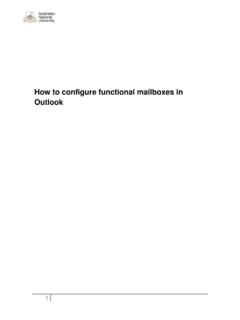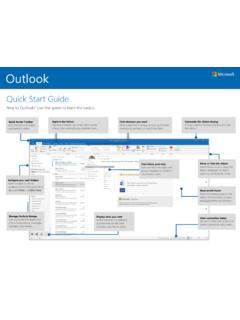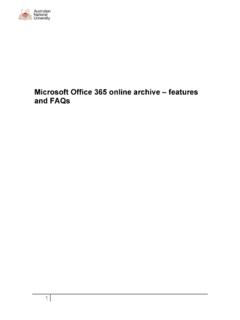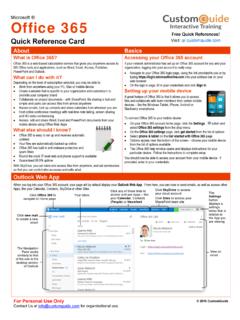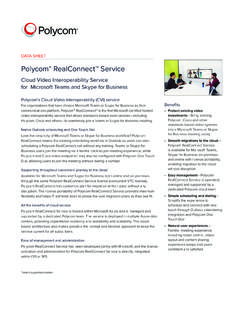Transcription of Staying Organized with the Outlook Journal - …
1 15 CHAPTERIn this chapterStaying Organized with theOutlook JournalIn this chapterUsing Outlook s Journal362Wo r king with the Journal Folder364 Setting Up Automatic email Journaling367 Using Journal s Other Tracking Capabilities370 Creating Journal Items Manually373 Creating Custom Journal Entry Types375 Troubleshooting376 Improving Your Outlook37818 0789729563 8/29/03 11:56 AM Page 361362 Chapter 15 Staying Organized with the Outlook JournalUsing Outlook s JournalOutlook s Journal is a lot like a diary and contains a record of your daily activities. Unlike adiary, it s somewhat limited to recording specific records, such as email you send andreceive, phone calls you make, and documents you work on. Although it does a good job ofautomatically tracking your usage of Microsoft Office applications, you must record journalentries for other events or applications the activities you can automatically record in the Journal are email you send and receive to selected contacts Task requests and responses Meeting requests, responses, and cancellations Telephone calls you initiate to a contact Office documents you work onBy automatically recording all documents you work on, all email sent to specific contacts,and phone calls made, the Journal keeps logs of your activity.
2 This is particularly useful toanyone who needs to know how long she worked on a document or spent on a phone callbecause the Journal tracks the elapsed time along with the you manually create new Journal entries, you re limited in the entry types you canchoose. The predefined entry types cover basic business events, such as Letters, documents, and faxes you send or receive Telephone calls and conversations Notes you take Remote sessions you participate in15 NOTEEven though you can t create new entry types in the form, you can edit the Registry toadd additional types to the drop-down list. See Creating Custom Journal Entry Types later in this chapter to learn how to create your own Journal entry Journal form (see Figure ) contains only a few basic fields: Subject Entry Type Company Start Time (includes time and date fields) Duration Notes18 0789729563 8/29/03 11:56 AM Page 362363 Using Outlook s JournalAfter you ve entered the information in the fields, press the Save and Close button and yourjournal item is a subject andnotes about the eventin the Journal formand you create Journal entries, you can use Views to organize your Journal : By Entry Type The default view.
3 Based on Timeline view with items grouped byentry type By Contact Based on Timeline view and grouped by contact By Category Based on Timeline view and grouped by category Entry List Based on the Table view format; initially sorted by creation date Last Seven Days Based on the Table view format; filtered to display entries createdwithin the past seven days Phone Calls Based on a Table view, filtered to display only phone callsYou might prefer to view your Journal in a traditional calendar format. If so, you can createa custom view using a day/week/month format can display the week numbers in a Timeline view. Right-click on the bar wherethe month and year are displayed, choose Other Settings, and then check the box in theScales section to Show Week Needs to Use the JournalAlthough many people don t use the Journal , doing so offers you two advantages.
4 The firstis that because the Journal can automatically record phone calls, email , task and meetingrequests, and responses for selected contacts, you can easily go back and verify that you sentan email or your colleague accepted an 0789729563 8/29/03 11:56 AM Page 363364 Chapter 15 Staying Organized with the Outlook JournalSecond, the Journal records the duration you worked on a task. If you bill by the hour orjust want to know how long you spent writing a report, the Journal can tell you. You don thave to remember to set a timer; you need only select the option to automatically record allfiles created using specific Office reason many people give for not using the Journal is that journaling causes your mail-box store to grow very large.
5 When the Journal automatically creates entries for many ofyour contacts and for all Office documents, you could end up with several hundred entriesat the end of each week, many of which offer little or no additional value. Unless you useAutoArchive to clean out the Journal regularly, you might have thousands of items in the Journal Is HelpfulYou can let the Journal automatically create records for Office documents or Outlook itemsyou create. Along with creating an automatic Journal item for you, it also records the timeyou spent working on the Journal entries aren t automatically created for all activities you might want toinclude in your Journal , it takes little effort to create Journal entries for all the activities youdo.
6 If you need to go back a few months and find a document you worked on, it s often eas-ier to look in the Journal and use views or Outlook s advanced find to find the Journal entrythan it is to search your computer s hard drive for filenames you can t with the Journal FolderWhen you open the Journal folder, you ll see the default By Type view: a timeline groupedby entry type. This view has the date running left to right across the top of the pane, withthe Journal entries listed under the dates. The Timeline view default shows seven days, asshown in Figure with scrolling, you can right-click on the row with the month and year to display thedate picker or, on the date scale, choose Go to Date to move around the Journal .
7 Althoughthe Outlook bar has a link for opening shared journals, only Exchange Server users can openand use shared Journal the View menu to select different views of your Journal folder, including timelinesgrouped By Contact or By Category and Table views showing all items, or filtered by thelast seven days, or limit the display to phone calls Reading Pane is turned off on the Journal folder by default; however, you can turn it onusing the View, Reading Pane menu selection. You can use the Reading Pane with any view,including the Timeline view, and you can see all the Journal fields in the Reading Pane. Forsecurity reasons, you can t open shortcuts on the Journal item from the Reading Pane; youhave to open the Journal entry first.
8 When the actual file is attached to the Journal entry,you can open it from the Reading Pane. In most views, you ll want the Reading Pane on thebottom of the window to maximize the viewing area for Timeline 0789729563 8/29/03 11:56 AM Page 364365 Working with the Journal FolderUsing ViewsThe Journal comes with six predefined views, using timeline or table layouts. You can cus-tomize these views or create your own custom views. You aren t limited to using Timeline orTable views with the Journal . Day/Week/Month views also work well with the Journal ,although Icon and Card views do following are Timeline views for grouping the Journal entries: By Entry type By Contact By CategoryEach of these views defaults to showing the journaled items for the week.
9 You can changethis to one day (segmented by the hour) or one month by pressing the Dayor Month tool-bar button. You can return to a seven-day view by clicking the Week of the first changes you might want to make in a Timeline view is reducing the size ofthe font used for the month and year. Right-click on the bar where the month and year aredisplayed, choose Other Settings, and then adjust the size of the Upper Scale Font in theFormat Timeline View dialog box, as shown in Figure options you can change from the Format Timeline View dialog box include showingweek numbers and changing the maximum width of the labels displayed with the icons. Youcan also control whether the icon label is displayed when viewing a month in the default view forthe Journal folder is aTimeline 0789729563 8/29/03 11:56 AM Page 365366 Chapter 15 Staying Organized with the Outlook JournalThe remaining preconfigured views use a Table view with filters controlling what you see.
10 Entry List No filter used Last Seven Days Filtered to display entries created within the past seven days Phone Calls Filtered to display only phone callsYou can customize any of these views or create new views using your own the timelinedisplay options usingthe Format TimelineView dialog you create entry types for incoming and outgoing phone calls, as described in Creating Custom Journal Entry Types, you ll have to modify the Phone Call view toshow the new entry the Journal ViewThe Journal comes with several views, all of which are customizable. Right-click on the toprow of the Journal and choose Customize Current View. The Custom View Organizeropens, enabling you to customize the current view to your liking.










